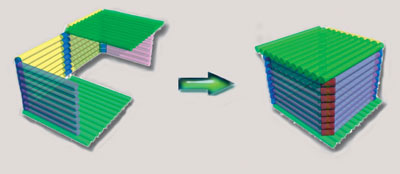| Posted: June 29, 2009 |
DNA boxes to encapsulate nanomaterials |
|
(Nanowerk News) DNA boxes to encapsulate nanomaterials have been constructed by Japanese researchers ("Design and construction of a box-shaped 3D-DNA origami" – free access article).
|
|
Assembling DNA molecules into organised and programmable structures is known as DNA nanotechnology. One important area is DNA origami in which single-stranded DNA is folded to construct arbitrary structures. These can then be used as platforms for nanostructures such as protein arrays, gold nanoparticles and messenger RNA.
|
 |
| The open-box DNA could encapsulate a guest molecule before being closed up into a box
|
|
Until now, researchers have focused on 2D origami, but Makoto Komiyama and Akinori Kuzuya at the University of Tokyo have shifted their focus to 3D structures. The pair folded DNA strands into an open-box shape and identified it using atomic force microscopy. 'For guest encapsulation, the box is designed to fold into an open form first, and can be closed afterwards by adding appropriate DNA strands,' explains Komiyama. 'The outside and inside of the box can be distinguished throughout the process so it may be possible to place a guest molecule in the face of the open form before closing it.'
|
|
The boxes are similar in size to virus capsids, which are currently gaining interest as nanocontainers, says Komiyama, but the faces of the DNA boxes are easier to chemically modify, enabling selective capture of various guest molecules.
|
|
|
|
Komiyama admits that this will be challenging. 'DNA is a polyanionic material, so the inner cavity of 3D origami is surrounded by thousands of anions,' he says. 'We will have to check if useful guests like proteins will enter such a small space and stay there.'
|
|
Kurt Gothelf, an expert on DNA nanotechnology at the University of Aarhus, Denmark, comments: 'DNA origami is going 3D and this box is a beautiful example. Like Hao Yan's DNA tetrahedron ("Mirror Image DNA Nanostructures for Chiral Supramolecular Assemblies") and our DNA box ("Self-assembly of a nanoscale DNA box with a controllable lid"), the internal cavity of this structure may potentially be used for drug delivery.'
|

